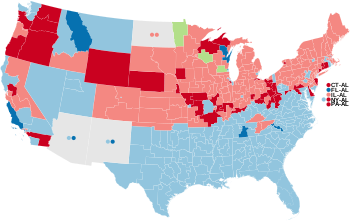The 1942 United States elections were held on November 3, 1942, and elected the members of the 78th United States Congress. In Democratic President Franklin D. Roosevelt's unprecedented third mid-term election and during World War II, the Republican Party picked up seats in both chambers. Still, the Democrats retained control of Congress.
| ← 1940 1941 1942 1943 1944 → Midterm elections | |
| Election day | November 3 |
|---|---|
| Incumbent president | Franklin D. Roosevelt (Democratic) |
| Next Congress | 78th |
| Senate elections | |
| Overall control | Democratic hold |
| Seats contested | 35 of 96 seats (32 Class 1 seats + 4 special elections)[1] |
| Net seat change | Republican +9 |
 | |
| 1942 Senate election results
Democratic gain Democratic hold | |
| House elections | |
| Overall control | Democratic hold |
| Seats contested | All 435 voting seats |
| Popular vote margin | Republican +3.8% |
| Net seat change | Republican +47 |
 | |
| 1942 House election results
Democratic gain Democratic hold | |
| Gubernatorial elections | |
| Seats contested | 33 |
| Net seat change | Republican +3 |
 | |
| 1942 gubernatorial election results
Democratic gain Democratic hold | |
In the House of Representatives, the Democrats lost forty-five seats, mostly to Republicans. The House elections took place after the 1940 United States census and the subsequent congressional re-apportionment. The Democrats also lost eight seats to the Republicans in the U.S. Senate. An Independent also lost his seat to a Republican in the Senate. Despite Republican gains, the Democratic Party retained control of both chambers.[2] The election was a victory for the conservative coalition, which passed the Smith-Connally Act and abolished the National Resources Planning Board over the objections of Roosevelt.[3]
Despite the threat and propaganda of World War II, voter turnout was a mere 33.9%. This is in stark contrast to other warring and Anglosphere nations during the period, with voting turnout being 71.1% in 1935 and 72.8% in 1945 in the UK; 69.9% in 1940 and 75.3% in 1945 for Canada, and 94.82% in 1940 and 95.13% in 1943 in Australia. This turnout was and still is historically low, with no other US biennial election yielding so small a turnout, although the 2014 elections remains a close second.[4][5]
See also
editReferences
edit- ^ One Class 1 seat held both a regularly-scheduled election and a special election in 1942. This seat is not double-counted for the total number of seat contested.
- ^ "Statistics of the Congressional Election of November 3, 1942" (PDF). U.S. House of Reps, Office of the Clerk. Retrieved 28 December 2011.
- ^ Busch, Andrew (1999). Horses in Midstream. University of Pittsburgh Press. p. 157.
- ^ Charlotte Alter. "Voter Turnout in Midterm Elections Hits 72-Year Low". Time. Retrieved November 11, 2014.
- ^ Charlotte Alter (November 10, 2014). "2014 midterm election turnout lowest in 70 years". PBS. Retrieved November 11, 2014.